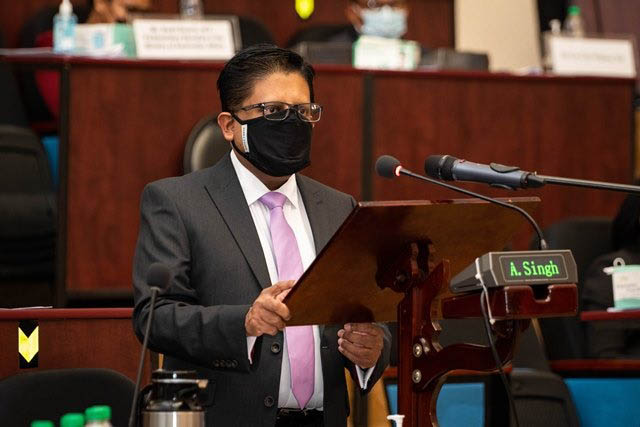Unveiling a record $383.1 billion budget for 2021, Minister with responsibility for Finance Dr Ashni Singh said yesterday that the economy is projected to grow by 20.9% if it reopens via a gradual lifting of COVID-19 restrictions.
This is less than half of the 43.5% growth which was recorded in 2020 but according to Singh, Guyana could very well see the non-oil sector this year grow by 6.1%. This growth would be a significant reversal of the 7.3% contraction recorded for the non-oil sector in 2020.
Singh, who presented the $383.1 billion budget to the National Assembly under the theme “A path to Recovery, Economic Dynamism and Resilience” at the Arthur Chung Conference Centre in the absence of the main opposition APNU+AFC, stated that though it is the largest budget ever laid — $53.5 billion larger than the 2020 budget — it will be financed without the addition of any new taxes.

The Minister was keen to highlight that the budget outlines a set of policies, programmes and projects which will not only directly catalyse economic growth, but will also see billions of US Dollars of private investment realised across several sectors of the economy. “Over and beyond oil and gas, the opportunities in agriculture, in tourism and hospitality, in manufacturing, in the service sector, all point to investment opportunity, and tens of thousands of jobs being created in the shortest space of time, generating incomes, and creating prosperity, at both an individual level and at a national level,” he told the House.
However, the overall deficit of the Central Government is projected to be 8.7 % of GDP, compared with 9.4 % at the end of 2020. The actual 2020 deficit sum is $90.5 billion, primarily as a result of higher-than-anticipated expenditure requirements. The 2021 deficit would be $33.3 billion on top of last year’s figure.
Singh explained that in 2020 total current revenue recorded was $227.4 billion, with 96% or $218.3 billion being earned from taxes. Non-tax revenue was $9.1 billion.
The increase in tax revenue above the 2020 budget estimate was, according to the Minister the result of higher-than-projected collections from internal revenue and excise taxes, which grew by $6 billion and $1.9 billion, respectively.
“Internal revenue was higher on account of larger-than-expected collections from private sector corporation tax and PAYE, which were $3.7 billion and $1.3 billion above the budget forecast,” Singh noted.
Meanwhile, tax revenue for 2021 is projected to reach $242.1 billion in 2021, while non-tax revenues are estimated at $15.8 billion for a total Central Government current revenue of $257.9 billion.
Total expenditure for 2021 is projected to reach $366.9 billion, 12.7% above the $325.5 billion spent in 2020.
Singh stressed that this increased expenditure will be driven mainly by an anticipated increase in expenditure for an intensified Public Sector Invest-ment Programme (PSIP).
With the inclusion of oil exports Guyana’s overall balance of payments recorded a surplus of US$60.6 million in 2020, compared to a deficit of US$48.9 million recorded in 2019.
Singh explained that the current account recorded a deficit of US$651.7 million in 2020 which was 76.9% lower than the deficit of US$2,823.7 million in 2019.
“The difference between the actual outturn for 2020 and the forecast resulted from a larger-than-projected merchandise trade surplus, US$514.8 million… reflecting the entry of oil exports into the balance of payments. This offset the lower-than-anticipated unrequited transfers and a higher-than-projected deficit on the net % account,” the minister explained.
A similar surplus of US$59.9 million is expected to be recorded in 2021. This is compared to a deficit of US$48.9 million recorded in 2019.
Speaking on Guyana’s debt, Singh said that at the end of December 2020, the ratio of total public and publicly guaranteed debt-to-GDP was 47.4 %. Total public debt at end-December 2020 was 53.3 % higher than at end-December 2019, mainly due to the inclusion of a large central government gross overdraft with the Bank of Guyana, racked up under the previous administration.
Liabilities
Additionally, all outstanding liabilities totalling about US$67.5 million or about $14.1 billion, under a government-guaranteed bond, issued in May 2018 by the National Industrial and Commercial Invest-ments Limited (NICIL) were classified as domestic debt due to the fact that the Government was required to meet debt service obligations under this bond during 2020.
In 2020, total public debt service payments amounted to US$92.3 million, an increase of 9.3 % compared to the preceding year, on account of higher domestic debt service costs. Total domestic debt service payments, in 2020, amounted to US$16.1 million, more than twice the 2019 figure of US$6.3 million, due to the need for government to meet debt service obligations under the NICIL bond. Conversely, external debt service payments shrank by 2.5 % in 2020, to US$76.2 million, mainly due to the completion of repayments under a rescheduled debt to Trinidad and Tobago.
Notably, while there is expected to be a nearly $20 billion (25.7%) increase in public enterprise receipts the overall public enterprise deficit is projected at $10.7 billion a significant increase from the $1.3 billion deficit recorded in 2020.
Singh explained that higher receipts are expected from the Guyana Power and Light and the Guyana Oil Company Ltd. (GUYOIL).
“The expected expansion of revenues at GUYOIL is based on a projected 17 % increase in its sales volumes, while GPL anticipates improvement of their collection rate on all billed sales,” Singh told the House.
Total operating expenditure is projected to expand by 26.6 % to $131.3 billion while capital expenditure is projected to increase to $26.1 billion.
The deficit of the non-financial public sector is targeted at $100.9 billion or 9.8 % of GDP.
In relation to the private sectors the Minister told the House that each sector of Guyana’s economy will see improvements.
The agriculture, forestry and fishing sector is expected to expand by 5.6% driven by growth across all subsectors. This is an improvement over the 4.1 % of growth recorded in 2020. The 2020 growth was largely reliant on growth in the rice, other crops, and livestock industries, which offset contractions observed in sugar, forestry and fishing.
Singh noted that the restructuring of the Guyana Sugar Corporation alongside the recapitalisation of sugar estates, will see improved production and productivity, not only in 2021, but over the medium-term.
“In 2021, the sugar industry is projected to grow by 9.6%. Additionally, with new high yielding varieties, the rice growing industry is forecasted to expand by 3.5% in 2021. The forestry, livestock, other crops and fishing industries are also expected to see improvements in 2021. These industries are projected to expand by 18.5 %, 5 %, 5 %, and 11.1 % respectively, driven by higher demand, and incentives provided for in Budget 2020,” he told the House.
The performance of the manufacturing sector is projected to improve by 7.3 % in 2021 on account of anticipated growth in sugar, rice, and other manufacturing. These three subsectors are expected to grow by 9.6 %, 8.7 % and 6.2 %, respectively.
The mining and quarrying sector is also forecasted to grow, in this case by 39.1 with increased earnings expected across all industries, namely oil, gold, bauxite, and other mining and quarrying.
Specifically in the oil and gas subsector, the daily rate of production for 2021 is expected to be just over 109,000 barrels of oil per day. This subsector is projected to grow by 46.7 % in 2021.
The gold mining subsector, which suffered some setbacks in 2020, is expected to grow by 4.2 % in 2021, largely due to the resumption of operations at the one large scale gold mine which had suffered a stoppage in 2020.
Also growing is the bauxite subsector, which faced major interruptions in 2020. It is expected to recover in 2021, and grow by 18.4 %.
Similarly, the other mining and quarrying subsector, which saw the largest contraction in 2020 as a result of lower demand, is projected to recover, and grow by 19.8 % in 2021, particularly with the anticipated scaling up of construction activities resulting in significant increases in the production of sand and stone.
The scaling up of construction activity is also expected to benefit the construction sector.
Singh stated that the resumption and expansion of public sector construction through the Public Sector Investment Programme, alongside growth in private sector investment in key infrastructural projects is likely to result in a 9.1 % growth rate for this sector in 2021.
He said that following the phased reopening of the economy, an overall growth rate of 5% is projected for the nearly dormant service sector.
“This is largely driven by anticipated expansions in wholesale and retail trade, transportation and storage, and financial and insurance activities, which are projected to grow by 10 %, 9.9 % and 7 %, respectively,” Singh said.
He had previously told the House that the sector is estimated to have contracted by 9.4 % in 2020.
“The overall decline could be attributed primarily to contractions in wholesale and retail trade and transport and storage. These subsectors fell by 28.3 % and 30.2 % respectively, outweighing expansions in information and communication, real estate activities, public administration and human health and social work, which grew by 5.5 %, 0.3 %, 1.2 % and 3.4 %, respectively,” he explained.






